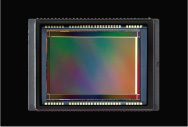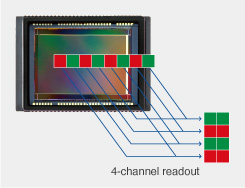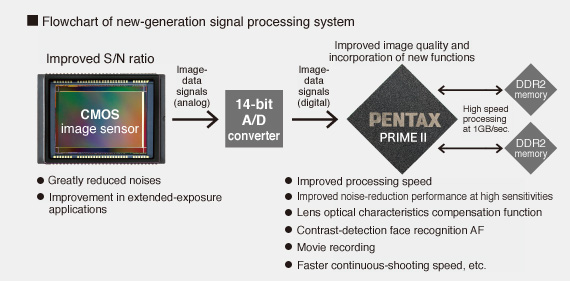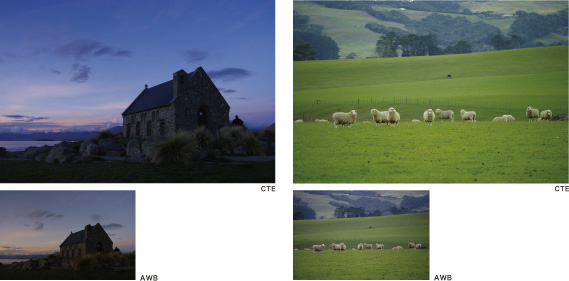Digital SLR Camera: K-7

- A perfect fusion of
size and quality - The essence of
a field camera - Dependable under
all conditions - Inspiring creativity
- Translating photographic sensi-
bilities into artistic expression - The ultimate
imaging power - An assortment of
picture-taking options - New possibilities
in visual expression - Newly developed
all-in-one software

New CMOS image sensor assuring high resolution and high S/N ratio — The product of advanced micromechanical semiconductor processing
The K-7 features a newly developed, advanced CMOS as its image sensor. In addition to a high S/N ratio achieved by PENTAX's micromechanical semiconductor processing technology and much-improved light-reception efficiency realized by a shallower depth, the image-sensor performance is enhanced by the reduction of different kinds of noise.
High-speed 4-channel data readout

Taking advantage of the CMOS image sensor's distinctive property allowing the simultaneously readout of charges from all individual pixels, the K-7 employs a four-channel data readout process. As a result, it offers high-speed continuous shooting at a maximum speed of approximately 5.2 images per second, despite its 14.6 effective megapixels.

New PRIME II imaging engine for
high-speed, intelligent processing of images and noises

The K-7 incorporates the newly designed PRIME II imaging engine. Combining this engine with DDR2 memory over two channels, the K-7 assures outstanding data-access speed. This greatly improved data-processing speed means that the K-7 assures better response and more intelligent image processing than previous models, while making a host of new functions available to the photographer. This sophisticated imaging engine is the end result of PENTAX's years of effort in developing digital imaging technologies.
Reduced high-sensitivity noise
During high-sensitivity shooting, low-frequency chromatic noise often causes the appearance of red and green in shadow areas. The PRIME II imaging engine, however, eliminates this noise by using an upgraded digital filter. It produces high-quality images with a smooth transition of gradations and a natural, true-to-life image description, even in situations with poor lighting.
Improved resolution
Interpolation processing uses RGB data obtained from individual pixels to reproduce true-to-life colors. The PRIME II imaging engine is designed to handle interpolation processing more meticulously than ever before, improving resolution and minimizing irregular color reproduction.
Superb gradation reproduction,
for faithful description of light and color from shadows to highlights
14-bit A/D conversion to process large-volume data
A 14-bit A/D converter processes analog signals output by the image sensor into digital signals. In theory, this converter can send the imaging engine up to four times (or 16384 gradations) the image data as conventional 12-bit converters (with 4096 gradations). This means that the K-7 can produce richer gradations, perform more meticulous image processing and offer more flexible image editing.
Dynamic-range expansion for delicate, natural gradations
With the K-7, shadow and highlight areas can be compensated simultaneously on the same screen. The peak level for highlights can be expanded by approximately one EV step* to prevent washed-out areas, or to more faithfully reproduce the texture of highly reflective materials. Shadows can be compensated at three levels (weak, medium or strong) to brighten up subjects standing against strong backlight or in the shade, as well as to prevent pitch-black areas. In both cases, the dynamic range is adjusted by the control of a tone curve.** Unlike exposure compensation, this has very little effect on the overall brightness of an image and assures a well-balanced description of both the subject and the background. Of course, you can always combine the dynamic-range expansion function with the exposure compensation function to obtain desired effects.

* When the dynamic range is expanded for highlights, the lowest-available sensitivity is ISO 200.
** Since shadows are compensated through tone-curve adjustment, the same compensation level may not yield identical results when the original images have different brightness levels.
State-of-the-art noise-reduction technology to assure high image quality at all sensitivities — The result of PENTAX's comprehensive approach to noise sources

By combining the new CMOS image sensor designed to minimize noise generation with the PRIME II imaging engine offering greatly improved noise-processing capabilities, the K-7 assures advanced digital SLR photography with minimal noise. Because of its high image quality, it also provides excellent flexibility in sensitivity setting, allowing more aggressive use of higher sensitivities. Even when shooting bright scenes at lower sensitivities, the camera effectively adjusts the effect of the sharpness mode to reduce the impact of noise. You can even intensify the image's sharpness level in the fine sharpness mode to produce extra-sharp images.
Two different functions to reduce noise
The high-sensitivity noise-reduction function offers minute adjustment of the noise-reduction effect, with the user selection of the minimum sensitivity required to activate the function. The intensity of the high-sensitivity noise reduction can be selected from three levels — weak, medium and strong — while the minimum sensitivity can be set to any level from ISO 200 to ISO 3200.
The K-7 also features an extended-exposure noise-reduction function, which can be easily switched on or off depending on your requirements. When turned on, the K-7 automatically performs all noise-reduction processes. And even when turned off, the K-7 automatically activates the function for bulb exposures longer than 30 seconds.
Versatile white-balance control system,
featuring a new mode
A choice of white-balance modes
The K-7 offers eight preset modes for white-balance control: Auto, Daylight, Shade, Cloudy, Fluorescent light (with a new color variation), Incandescent light, Flash, and CTE. Manual white-balance control is also available; pick an area within the image that you want to reproduce as pure white in the recorded image. You can also directly input a desired color temperature, or enter into memory up to three different color temperatures of your choice.
New CTE mode to emphasize primary color
Generally speaking, the AWB (auto white-balance) control function is designed to minimize the effect of color-temperature differences on colors and standardize the camera's color reproduction performance. In other words, when the color temperature is high, the camera will attempt to make the image appear as if taken at a lower temperature; if magenta is prominent, the camera will attempt to compensate for this by moving the image's color scheme toward green. Because of this, primary colors that you want to faithfully express in the image — such as red in sunset scenes or green in landscapes — may sometimes look dull and washed-out. The K-7's new CTE option is an innovative white-balance control mode designed to work in the exact opposite way to AWB — that is, to emphasize a primary color. Using this mode, the sun's glow at dawn and dusk or a snowfield under the cloudy sky will all be expressed in vivid colors. This mode also prevents colors from being washed out, whether the sparkling green of trees or the faint pink of cherry blossoms, so you can produce lively, color-rich images.
New lens characteristics compensation function
to minimize distortions and color shifts
Taking advantage of an extensive database developed over the years to cover the optical characteristics of all smc PENTAX lenses, PENTAX has equipped the K-7 with this unique function.
Distortion compensation
This function effectively compensates for barrel- and spool-type distortions, problems common to wide-angle and zoom lenses.
Lateral chromatic aberration compensation
This function effectively compensates for lateral chromatic aberration, preventing color bleeding and producing beautiful images with edge-to-edge sharpness.
You can also compensate for brightness at the peripheral areas of an image using the PENTAX Digital Camera Utility 4 software (included in the K-7 Lens Kit).
Notes:
• This function is available only with DA-, DA Star- and DA Limited-series lenses. This function cannot be selected when any other lens is mounted on the K-7 camera body.
• The extent of compensation will vary depending on the shooting conditions.
• Distortion compensation is not available with the DA Fish-Eye 10-17mm F3.5-4.5 ED [IF] zoom lens.
• This function is not available when using optional extension tubes, or during multiple-exposure shooting.
• This function may reduce the speed of continuous shooting.
• When shooting RAW-format images, this function can be turned on and off during the in-body RAW-data development process.
- A perfect fusion of
size and quality - The essence of
a field camera - Dependable under
all conditions - Inspiring creativity
- Translating photographic sensi-
bilities into artistic expression - The ultimate
imaging power - An assortment of
picture-taking options - New possibilities
in visual expression - Newly developed
all-in-one software



